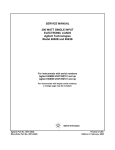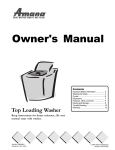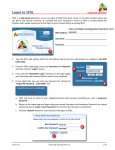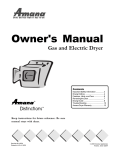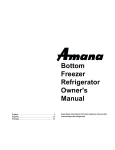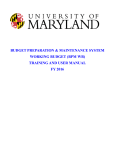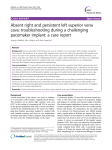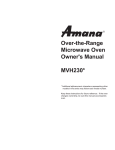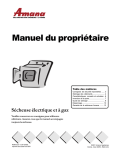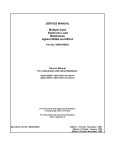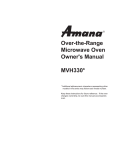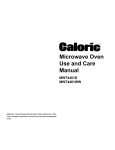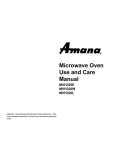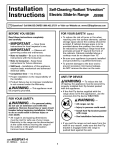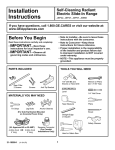Download Gas Cooktop Use & Care Manual RTP201*
Transcript
® Gas Cooktop Use & Care Manual RTP201* * Additional alphanumeric characters representing other models in series may follow each model number. Please Read Manual Before Operating Cooktop Installer Leave this manual and other literature with consumer for future use. Customer Keep these instructions for future reference. If ownership changes, manual must accompany cooktop. Model Identification ................................................ 2 Parts and Accessories ............................................ 2 Service ................................................................... 2 Asure™ Extended Service Plan ............................. 2 Important Safety Information ..................................... 3 Cooking Controls .................................................................. 4 Flame ..................................................................... 4 Care and Cleaning General Cleaning ................................................... 4 Cleaning Inside ....................................................... 5 Maintop Cleaning ................................................... 6 Control Panel Cleaning ........................................... 6 Top Burner Cleaning .............................................. 6 Before Calling for Service ....................................... 7 Be sure appliance has been installed properly and in accordance with all specifications and local codes prior to use. On models with pilot lights, if the burner does not light, check to see if the pilot is ignited. If necessary relight with a match. If the burner will not light on electric ignition models check to be sure the control has been turned to the “light” position. Check to see that the power cord is plugged in. Model Identification Complete enclosed registration card and promptly return. If registration card is missing, call Consumer Affairs Department at 1-800-843-0304 inside U.S.A. 319-622-5511 outside U.S.A. When contacting Amana, provide product information. Find product information on rating label located on bottom of cooktop. Record the following: Model Number: ______________________________ Manufacturing Number: ________________________ Serial or S/N Number: _________________________ Date of purchase: ____________________________ Dealer’s name and address: ____________________ __________________________________________ __________________________________________ Parts and Accessories Purchase replacement parts and additional accessories (e.g. refrigerator shelves, dryer racks, or cooktop modules) over the phone. To order accessories for your Amana product, call 1-800-843-0304 inside U.S.A. or 319-622-5511 outside U.S.A. Service Keep a copy of sales receipt for future reference or in case warranty service is required. Any questions or to locate an authorized servicer, call 1-800-NAT-LSVC (1-800-628-5782) inside U.S.A. 319-622-5511 outside U.S.A. Warranty service must be performed by an authorized servicer. Amana, also recommends contacting an authorized servicer if service is required after warranty expires. Asure™ Extended Service Plan Amana offers long-term service protection for this new cooktop. Asure™ Extended Service Plan is specially designed to supplement Amana’s strong warranty. Asure™ provides budgetable protection for up to 3 additional years. This plan covers parts, labor, and travel charges. Call 1-800-528-2682 for information. 2 Important Safety Information WARNING WARNING This gas appliance contains or produces a chemical or chemicals which can cause death or serious illness and which are known to the state of California to cause cancer, birth defects or other reproductive harm. To reduce the risk from substances in the fuel or from fuel combustion make sure this appliance is installed, operated, and maintained according to the instructions in this booklet. To avoid serious burns or other personal injury, do not store items of interest to children above or behind cooktop. Children climbing on cooktop to reach items could be seriously injured. Be careful when reaching into storage cabinets above cooktop while it is in operation. One might accidentally contact a hot cooktop when using a hand for support or have one’s clothing come in contact with top burner flames. WARNING Do not leave children alone or unwatched near the cooktop when it is in use or while the surfaces are still hot from use. Let burner grates and other surfaces cool before touching them. To avoid death, personal injury or property damage, information in this manual must be followed exactly. Do not store or use gasoline or other flammable vapors and liquids in the vicinity of this or any other appliance. Do not wear loose fitting garments near the cooktop while burners are in operation due to the possibility of fabric ignition which may result in personal injury. WHAT TO DO IF YOU SMELL GAS • Do not try to light any appliance. • Do not touch any electrical switch; do not use any phone in your building. • Immediately call your gas supplier from a neighbor’s phone. Follow the gas supplier’s instructions. • If you cannot reach your gas supplier, call the fire department. Always be certain parts of top burner area are cool before touching with hands unprotected by a pot holder. Use dry pot holders, never a trailing or moist towel, apron, etc., when handling pans on the cooktop. This will prevent burns to your hands from steam and avoid the possibility of a fire. Do not use the top burners to heat the kitchen. Grate finishes may chip without a pan to absorb the heat and adjacent surfaces may not withstand the resultant heat. Installation and service must be performed by a qualified installer, service agency or the gas supplier. If your cooktop is near a window, use an appropriate window treatment—no long curtains which could blow over the cooktop and create a fire hazard. CAUTION Do not obstruct the flow of combustion or ventilation air. 3 Cooking About the Amount of Liquid to Use Use as little liquid as possible since foods cook as fast or faster and better in small amounts of water. When food is cooked, if there is some liquid left, serve it with the food or save it to use in other cooking. Many vitamins dissolve in the cooking water and are lost if it is discarded or drained off. About Covers A good fitting cover makes a utensil perform better. It keeps temperatures in the pan more even and holds in heat, odors and steam. Food can be cooked with less water and will retain more vitamins. Cover pans whenever you can, so foods can cook with maximum speed and minimum cleanup. Controls The burner control dials for each of the top burners are on the control panel beside the burners. The control panel is marked to show which burners the dials control. Flame The gas flame can be set at any desired height. After lighting the burner you can set the flame at high, medium or low by turning to the desired click position. The dial can also be set between the clicks for precise flames. What is the Right Flame Height? Proper flame height depends on the utensil size and material, what you are cooking, and whether you are cooking with liquid. Here are some basic rules for selecting flame height. 1. The flame should never extend beyond the bottom of the pan. Any larger flame is wasted heat and only serves to heat the pan handles and the kitchen as well as the food. Utensils When you are buying pans, look for utensils that are well balanced so they do not tilt when only partially filled. Remember too, that utensils cook best when nearly full so choose sizes to fit the quantity of food you cook. Just be sure the pan is not so small that you risk a spill-over. Pan Materials Pan materials have certain basic characteristics, some can be drawbacks. While these characteristics cannot be changed, utensils can be modified by combining materials, using special coatings or other techniques. Also, a particular characteristic is important for one type of pan and not another. Good heat conductivity is very important in a skillet, for example, but matters little in a coffee pot. Since the utensil is important in top burner cooking, perhaps some basic information will be helpful. Remember that good quality utensils are the least expensive in the long run. 2. Utensils which conduct heat slowly (stainless steel, cast iron, enamel, glass and glass ceramic) should be used with a low or medium flame unless you are cooking with a liquid. With no liquid, a high flame, and a pan material which transfers heat slowly, pan temperatures can be very uneven. The pan will be hot where the flame touches, but much cooler in other spots. At a lower flame, the same utensil heats gradually and much more evenly. As a general rule, to fry in pans which conduct heat slowly, adjust the burner to a low or medium flame, about 1/3 the diameter of the pan. This takes a little longer, but gives the best results. If you are boiling or simmering, the liquid helps to conduct heat and keep pan temperature even. Then you can use a higher flame, but never higher than the bottom of the pan. 3. Foods cook just as quickly at a gentle boil as at a furious rolling boil - in both cases the water temperature is 212°. A high boil only creates steam in the kitchen and cooks away moisture, flavor and nutrients. Avoid it except for the few cooking processes which need a vigorous boil. Combinations of Materials Combination pans - copper and stainless steel, stainless clad aluminum, for example - have some of the properties of both metals. Generally speaking, they will conduct heat as well as the predominant material and will require the same care as the surface material. 4 Care and Cleaning Special Coatings Porcelain enamel is one coating which is used to make utensils easier to care for. Applied to cast iron, for example, it makes the utensil rustproof. General Cleaning Avoid Harsh Cleansers For your cooktop to retain a new appearance, care must be taken to protect the porcelain enamel and metal finishes. Never use gritty cleansers on porcelain enamel or polished metal trim. In time they will “age” your cooktop. Never use oven cleaner, which is highly alkaline, on exterior finishes, trim or aluminum parts. A second type of coating being used on many different utensils is a plastic called Teflon. Because it is a very slick surface, foods will not stick to it and this makes cleaning much easier. High heat, sharp tools, and scouring powders or pads can damage or destroy the finish. Otherwise, the pan is used just as you would a similar uncoated pan. Wait for the Surfaces to Cool Do not wash or wipe any of the enamel parts while the unit is still warm from operation. Sudden temperature changes can cause the glass-like enamel to crack. Aluminum Aluminum conducts heat very well and, therefore, heats quickly and uniformly. Foods brown very evenly in an aluminum skillet. It comes in many weights but a medium to heavy weight generally give best performance. Minerals in food and water will stain but do not harm it, nor is this discoloration harmful to food or people. A quick scour with a soap-filled steel wool pad after each use keeps aluminum pans looking shiny-new. Prevent Acid Stains Vinegar, milk, citrus fruits, marinades and sauces with tomatoes contain acids which can stain or discolor even the finest acid-resistant materials and finishes. Do not allow these acids to come in contact with your cooktop. If a spill occurs, wipe it up immediately with a dry cloth. When the surface is cool, wash with warm soapy water and dry. Cast Iron Cast iron is a very durable material, but it is quite heavy and is subject to rusting unless coated with porcelain enamel. It is a moderately good heat conductor. Ordinary Stains In most cases ordinary stains can be removed with baking soda and a damp cloth. If the stain remains, use mild cleanser taking care not to scratch or mar the finish. Glass Glass Pyrex, for example, is inexpensive, easily cleaned and nonporous; food is visible as it cooks. There are two types of glass utensils, those for oven use only and those for cooktop cooking (saucepans, coffee and tea pots). The ovenware will break if used for top burner cooking; the top burner-ware will break in the oven; both can break with abrupt temperature changes like setting a hot pan on a cold surface. Glass conducts heat very slowly. Chrome Finishes Never use steel wool, scouring powder, oven cleansers or abrasives on bright metal or painted surfaces. Usually a damp cloth will wipe chrome surfaces clean. Use any good chrome cleaner if the stains don’t wipe off easily. Burner Knob Do not use a scouring pad or scouring powder to clean burner knobs. The numerals can be rubbed off the knobs by the abrasive action. Ceramic Glass Glass ceramic Corning Ware, for example, is very hard, non-porous, easily cleaned and resists all temperature changes. It can be used for either cooktop or oven cooking. It conducts heat very slowly. The bottom area of the grate is not covered by porcelain enamel and therefore should be dried thoroughly to prevent rusting of the prongs. Also due to the glass-like nature of enamel, it may sometimes chip from the prong area; however, this does not affect the performance of the cooktop. Stainless Steel Stainless steel is one of the most easily cleaned metals now, is extremely resistant to heat and corrosion and requires no polishing. Utensil Care Follow the manufacturer’s instructions. This is another area where a little care frequently saves a big cleaning job. Be sure, especially with skillets, that pans are shiny clean with no food left to cause sticking, the next time you use the pan. 5 Cleaning Inside Top Burner Cleaning Remove the burner bowls and grates and lift off the burner knobs. Then unlock the main top by releasing the catches located in the burner bowl opening. Be sure the main top and burners are cool before removing them. Remove the main top as explained. Then remove the burners for cleaning. Be certain the 4 burner mounting screws are removed from the bracket at the burner head before attempting burner removal. If the shipping screws are still in place, they can be removed with a Phillips screwdriver. Grasp the burner at the burner head and lift upward with a slight movement away from the burner control dials. Grasp the main top between the burner opening and lift upward. The outside of the unit can now be wiped clean (the burners can be lifted out for easier cleaning). As burner box interior is porcelain enamel, it should be treated accordingly. Allow to cool first, then wash with soapy water and a sponge. Wipe dry with a towel. Maintop Cleaning If the maintop of your appliance has a porcelain enamel finish, allow it to cool and then wash it with soapy water and a sponge. Do not use harsh abrasives since they may scratch or mar the finish. Wiping the burners following each use will remove spillover deposits and grease splatters before these soils get a chance to harden on the surface. Burned on soil can be cleaned by soaking the burners in a warm water and dishwashing liquid detergent such as “Dove®” or “Lux®”. A dishcloth or non-abrasive pad (such as Dobie® pad) should be used to rub the burner caps before the soaking period. Be sure the burners are dry, as water lodged in the burner parts might cause an uneven flame or interfere with automatic lighting. Stainless steel tops may be cleaned with available stainless steel cleaners, such as “Cameo Aluminum & Stainless Steel Cleaner®”. Be sure to rub in the same direction as the brushed grain finish of the top. Stubborn stains can be removed by using a nylon scouring pad, such as “Scotch Brite®” pad, and rubbing carefully in the same direction as the brushed grain finish of the maintop. If stains still remain after soaking you can soak any heavily-soiled burners in a solution of two tablespoons of “Dip-It®” per quart of water. Use a large pan and enough water so the cap and base part of the burner assembly can be completely immersed; bring water to a boil, remove vessel from burner, and add measured amount of “Dip-It®”. Immerse the burner in the hot solution and soak for 20 minutes, no longer. Be sure the liquid completely covers the cap and base portion of the assembly. After 20 minutes, remove burner, cool slightly and rinse thoroughly with cold water. Be sure hands are protected to prevent burns from hot water. Be sure all the solution is completely rinsed off both the inside and outside of the burner. If some stains still remain, rub with a “Dobie®” pad. 6 Before Calling for Service Do not use wooden pick to clean the holes. Be sure the burners are dry, as water lodged in the burner parts might cause an uneven flame or interfere with automatic lighting. (The burners can be heated in the oven to dry them. Simply place the burners in the oven on the oven racks and set the dial to 170°. Leave in about 30 minutes.) Your cooktop is engineered to give you many years of faithful service. It has been thoroughly tested before leaving the factory. If properly cared for, your built-in unit should not require service. However, if your unit fails to perform properly, we suggest you check the following before calling for service. When replacing burners be sure they are in the correct positions. Top burner will not light Check the top pilots to be sure both are ignited. If not, relight by lifting the main top and light with a match as shown. For main top removal instructions, see page 6. Relighting Top Pilots If the top pilots should be extinguished while cleaning the unit, relight them with a match as shown. This unit can be converted from one type of gas to another without additional conversion parts. Instructions for conversion are contained in Installation Instructions. If service is required, contact an authorized service center in your area at 1-800-NATLSVC (628-5782) inside the U.S.A. and 319-622-5511 outside U.S.A. 7 Part No. 36-31765301-0 Printed in U.S.A. 1997 Amana Amana, Iowa 52204








